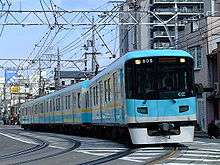Keihan Electric Railway




Keihan Electric Railway Co., Ltd. (京阪電気鉄道株式会社 Keihan Denki Tetsudō Kabushiki-gaisha) (TYO: 9045) is a Japanese railway operator in Osaka, Kyoto, and Shiga Prefectures. It is known as "Keihan" (京阪), "Keihan Dentetsu" (京阪電鉄) or "Keihan Densha" (京阪電車).
History
Keihan started its operation between Osaka and Kyoto in 1910. It was the first electric railway to connect these two cities, and the first line on the left bank of Yodo River. Keihan later purchased the lines in the Ōtsu area (Ōtsu Lines).
In the 1920s, Keihan built another Osaka-Kyoto line through its subsidiary Shinkeihan Railway (新京阪鉄道 Shin-keihan-tetsudō), which merged into Keihan in 1930. This line is now known as Hankyu Kyoto Line.
In 1943, with the power given by the Land Transport Business Coordination Act (陸上交通事業調整法 rikujō-kōtsū-jigyō-chōsei-hō) (Act No. 71 of 1938), the wartime government of Japan forced Keihan to merge with Hanshin Kyūkō Railway to form Keihanshin Kyūkō Railway (京阪神急行電鉄 Keihanshin Kyūkō Dentetsu). In 1949, the pre-war Keihan operations, except for Shinkeihan lines, restored independence under the original corporate name. Keihanshin Kyūkō Railway later changed the name to present Hankyu Railway.
Lines
The lines operated by Keihan are grouped into Keihan Lines and Ōtsu Lines. The former operates between Kyoto and Osaka with long formation of larger rolling stock. The latter runs Kyoto and Ōtsu with more tram-like cars. The entire network has 1,435 mm (4 ft 8 1⁄2 in) standard gauge double track.
Current lines
Keihan Lines
- Keihan Main Line: Yodoyabashi - Sanjo
- Ōtō Line: Sanjo - Demachiyanagi
- Nakanoshima Line: Nakanoshima - Temmabashi
- Katano Line: Hirakatashi - Kisaichi
- Uji Line: Chushojima - Uji
Ōtsu Lines
- Keishin Line: Misasagi - Hamaotsu
- Ishiyama Sakamoto Line: Ishiyamadera - Sakamoto
Other lines
- Cable Line (鋼索線), also called Otokoyama Cable (男山ケーブル)
Closed lines
- Keishin Line: Keishin-Sanjo (Sanjo) - Misasagi
Unbuilt line
- Umeda Line
Rolling stock
Keihan fleet as of October 2008[1]
Keihan Lines
- 1900 series 5-car EMUs x 2 (introduced 1963)
- 2200 series 7-car EMUs x 14 (introduced 1964)
- 2400 series 7-car EMUs x 6 (introduced 1969)
- 5000 series 7-car EMUs x 7 (introduced 1970)
- 8030 series 8-car EMU x 1 (introduced 1971)
- 1000 series 7-car EMUs x 6 (introduced 1977)
- 2600 series 7-car EMUs x 6, 5-car EMUs x 8, 4-car EMUs x 5 (introduced 1978)
- 6000 series 7/8-car EMUs x 14 (introduced 1983)
- 7000 series 7-car EMUs x 4 (introduced 1989)
- 8000 series 8-car EMUs x 10 (introduced 1989)
- 7200 series 8-car EMUs x 2, 7-car EMU x 1 (introduced 1995)
- 9000 series 8-car EMUs x 5 (introduced 1997)
- 10000 series 4-car EMUs x 6 (introduced 2002)
- 3000 series 8-car EMUs x 6 (introduced 2008)
- 13000 series 4-car EMUs x 5 (to be introduced from spring 2012)
Ōtsu Lines
- 600 series 2-car EMUs x 10
- 700 series 2-car EMUs x 5
- 800 series 4-car EMUs x 8 (introduced 1997)
Fares
Train fare varies based on travel distance. As of January 1, 2009, IC cards (PiTaPa and ICOCA) are accepted on the Keihan Lines and the Otsu Lines, but not on the Cable Line. The fare rate was changed on April 1, 2014 to reflect the change in the rate of consumption tax from 5% to 8%.[2]
Keihan Lines (Keihan Main Line, Oto Line, Nakanoshima Line, Katano Line, Uji Line)
| Distance (km) | Fare (JPY) | |
|---|---|---|
| effective April 1, 2014[2] | effective October 19, 2008 | |
| 1-3 | 150 | 150 |
| 4-7 | 210 | 200 |
| 8-12 | 270 | 260 |
| 13-17 | 310 | 300 |
| 18-22 | 330 | 320 |
| 23-28 | 350 | 340 |
| 29-34 | 370 | 360 |
| 35-40 | 390 | 380 |
| 41-46 | 400 | 390 |
| 47-52 | 410 | 400 |
| 53-54 | 420 | 410 |
- Additional fare when taking or passing the following lines
- Oto Line: 60 yen
- Nakanoshima Line (Nakanoshima - Oebashi): 60 yen
- When using commutation tickets, Naniwabashi Station is treated as the same station as Kitahama Station, and Oebashi Station as that as Yodoyabashi Station.
Otsu Lines (Keishin Line, Ishiyama Sakamoto Line)
| Distance (km) | Fare (JPY) | |
|---|---|---|
| effective April 1, 2014[2] | effective October 19, 2008 | |
| 1-5 | 170 | 160 |
| 6-10 | 240 | 230 |
| 11-15 | 320 | 310 |
Cable line
- 200 yen
Etymology
The name Keihan is derived from the words Kyoto and Osaka in Japanese. The characters for Kyoto are 京都 and Osaka's are 大阪. The first character from Kyoto and the second from Osaka make 京阪, which can be read "Keihan".
Other businesses
Keihan also operates (through the subsidiaries) other businesses such as bus, taxi, water bus, hotel, department store and amusement park, mainly in the area along its railway system.
References
- ↑ "早わかり京阪電車" (Quick Guide to Keihan EMUs), Tetsudō Daiya Jōhō magazine November issue, p.44-55
- 1 2 3 Keihan Electric Railway Co., Ltd. (March 4, 2014). "平成26年4月1日(火)からの消費税率引上げに伴う旅客運賃の認可および改定について" (PDF). Retrieved October 19, 2014.
External links
| Wikimedia Commons has media related to Keihan Electric Railway. |
- Keihan Electric Railway (Japanese)
- Keihan Electric Railway (English)